Physical Address
304 North Cardinal St.
Dorchester Center, MA 02124
Since the initial description of pseudosarcomatous fibroepithelial stromal polyps of the distal female genital tract in the early 1960s, various relatively site-specific mesenchymal lesions of the lower genital tract have been recognized. These lesions are often diagnostically challenging because of their morphologic overlap, which in part stems from their likely shared origin from the specialized subepithelial stroma of the distal female genital tract. Ancillary studies such as immunohistochemistry are often not helpful in their distinction; thus one must firmly rely on morphologic features to distinguish among these tumor types.
Among the relatively site-specific soft tissue tumors of the distal female genital tract discussed herein, the diagnosis of deep (aggressive) angiomyxoma has the greatest impact on the patient with regard to prognosis and potential morbidity; therefore its recognition is of paramount importance. Consequently, a useful approach to spindle cell tumors at this site is to be familiar with the characteristic clinical and pathologic features of deep (aggressive) angiomyxoma and to be aware of how it differs from the other lesions. In general, issues to be considered are the following:
Is the lesion myxoid?
Is the lesion deep seated (as seen in deep angiomyxoma) or superficial/subcutaneous?
If it is superficial, is it polypoid/exophytic, which would argue strongly against deep angiomyxoma?
Is the lesion infiltrative (as seen in deep angiomyxoma) or well circumscribed?
Does the lesion have a vascular component?
If there is a vascular component, is it composed of predominantly medium- to large-caliber blood vessels (typical of deep angiomyxoma), or are they small?
Since its initial description by Steeper and Rosai in 1983 as a locally infiltrative tumor of adult women, which tends to recur, resulting in significant morbidity (hence the original terminology of aggressive angiomyxoma ), it has become evident that these lesions have a favorable, less aggressive course if initially completely excised. Current terminology therefore favors the designation “deep angiomyxoma” to reflect its tendency to involve deep soft tissue. Deep angiomyxoma is also discussed in Chapter 5 .
Deep angiomyxoma typically occurs in the pelvis and perineum of reproductive-aged women, with a median age in the fourth decade. However, it may also rarely arise in the inguinoscrotal region of men. In women, it may be clinically mistaken for a labial cyst, most commonly a Bartholin gland cyst. Deep angiomyxoma can vary in size but is often relatively large (>10 cm).
Deep angiomyxoma is characteristically a soft, gelatinous tumor with ill-defined margins on gross examination. Histologically, it is uniformly paucicellular, composed of bland spindle cells with delicate cytoplasmic processes set within copious myxoid stroma ( Fig. 17.1 ). Evenly distributed throughout are medium- to large-sized vessels, which are often thick walled and hyalinized. Loose fibrillary collagen and collections of smooth muscle cells (so-called myoid bundles) are typically arranged in either loose clusters or tight whorls adjacent to blood vessels ( Fig. 17.2 ). Deep angiomyxoma has deceptively infiltrative borders, and thus its borders are difficult to define both surgically and pathologically. This problem likely explains its propensity to recur, because incomplete excision is associated with a high rate of recurrence.
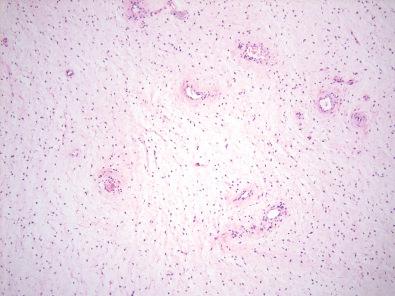
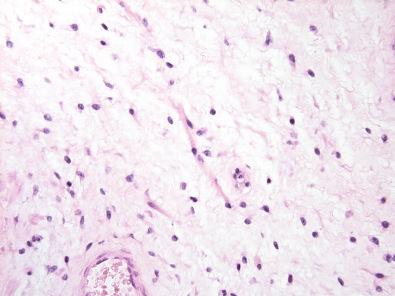
The lesional stromal cells are usually positive for estrogen receptor (ER), progesterone receptor (PR), and desmin, as well as sometimes positive for smooth muscle actin. The myoid bundles are positive for smooth muscle markers. Nuclear expression of HMGA2 is seen in many but not all cases.
Structural rearrangements of the region 12q15 with involvement of HMGA2 are the most frequent chromosomal aberrations observed in deep (aggressive) angiomyxoma; the break involving 12q15 may occur within or outside of the gene. Overall, 12q15 rearrangements occur in approximately 30% of cases. However, detection of HMGA2 expression by immunohistochemistry does not always correlate with gene rearrangement and thus may only be useful in confirming the diagnosis or assessing margin status in a subset of cases.
Fibroepithelial stromal polyps can sometimes be edematous, usually secondary to torsion, and mimic deep angiomyxoma. However, stromal polyps are superficial lesions that are more commonly polypoid and have a central fibrovascular core rather than the uniformly distributed vascular component of deep angiomyxoma. In addition, stromal polyps characteristically contain multinucleate cells (not a feature of deep angiomyxoma) and lack perivascular cuffing by collagen and myoid bundles (typical features of deep angiomyxoma).
Superficial angiomyxoma (see also Chapters 5 and 15 ) may be considered in the differential diagnosis of deep angiomyxoma because both are myxoid neoplasms composed of bland spindle cells. However, the former occurs in superficial cutaneous and subcutaneous locations and shows a lobulated growth pattern with well-defined borders, which contrasts with the more deeply situated, ill-defined deep angiomyxoma. In addition, superficial angiomyxoma contains more delicate, thin-walled vessels. Moreover, it is negative for desmin, in contrast to deep angiomyxoma, which is commonly positive for this marker. As a practical point, in some instances, superficial angiomyxoma may be excised without overlying dermis. Its superficial location can usually be determined by the presence of adnexal structures located between the myxoid tumor nodules.
Angiomyofibroblastoma is another relatively site-specific mesenchymal tumor of the distal female genital tract that occurs in reproductive-aged women. It is composed of bland spindle cells and hypocellular areas that may mimic deep angiomyxoma. In contrast to deep angiomyxoma, angiomyofibroblastoma is a nonrecurring, well-circumscribed, typically subcutaneous mass. It classically exhibits areas of alternating cellularity with hypercellular zones merging with less cellular areas, which contrasts with the uniformly hypocellular appearance of deep angiomyxoma. In addition, angiomyofibroblastoma contains more numerous blood vessels, which are typically capillary sized, as opposed to the large thick-walled vessels of deep angiomyxoma. The lesional cells of angiomyofibroblastoma, which are commonly epithelioid in appearance with more abundant eosinophilic cytoplasm, tend to cluster around the vasculature in a characteristic configuration. Because both lesions are often desmin positive, immunohistochemistry is not useful in the differential diagnosis.
Prepubertal vulval fibroma is characterized by a poorly marginated, patternless proliferation of bland spindle cells. In contrast to deep angiomyxoma, this lesion typically occurs in young girls and is more superficially located in submucosal or subcutaneous soft tissue. Although both tumors can have myxoid stroma, deep angiomyxoma is more uniformly myxoid, has a more delicate collagenous matrix, and typically contains myoid bundles. In addition, unlike deep angiomyxoma, the spindle cells of prepubertal vulval fibroma are positive for CD34 and negative for desmin.
Massive vulval edema, most commonly secondary to immobilization or obesity, can mimic deep angiomyxoma because it can form a masslike lesion, lacks circumscription, and has a hypocellular appearance. However, massive edema is usually bilateral, has an edematous and not myxoid stroma, often shows perivascular lymphoid inflammation, and typically is negative for ER and HMGA2.
Deep angiomyxoma has a propensity for local recurrence, sometimes many years (even decades) after the initial excision. Destructive recurrences may occur, but only if the tumor was initially incompletely excised (hence the previous use of the term aggressive ). Wide local excision with 1-cm margins is considered optimal treatment. Because these tumors are ER positive, hormonal therapy may play a role in patients with extensive or recurrent disease.
This infiltrative, hypocellular myxoid tumor of the distal female genital tract has the potential for local, sometimes destructive recurrence
Typically involves deep soft tissue and is rarely polypoid
Abundant myxoid stroma, bland spindle cells, and uniformly distributed medium- to large-sized blood vessels with hyalinized walls are characteristic
Immunohistochemistry is not helpful because most other mesenchymal tumors of the distal female genital tract share the same immunoprofile
Fibroepithelial stromal polyps are hormonally responsive lesions that are thought to arise from specialized subepithelial stromal cells of the distal female genital tract. Although there is an association with pregnancy, they may occur at any time during the reproductive years and have also been associated with hormonal replacement therapy in perimenopausal and postmenopausal women. Following pregnancy, the polyps typically regress, a finding that suggests they represent a benign reactive proliferation responding to an altered hormonal environment (e.g., pregnancy). Lesions that occur during pregnancy have sometimes been termed pseudosarcoma botryoides because of their increased cellularity and atypia. However, consideration of sarcoma botryoides (botryoid embryonal rhabdomyosarcoma) is rarely, if ever, truly a diagnostic concern, given the differences in clinical presentation and lineage.
Patients typically present with polypoid or pedunculated lesions, which may vary in size, but are generally smaller than 5 cm. They are usually solitary, although multiple polyps may occasionally occur (most commonly during pregnancy).
Fibroepithelial stromal polyps are polypoid proliferations of stroma with a variably hyperplastic overlying squamous epithelium and a central fibrovascular core that often contains thick-walled blood vessels ( Fig. 17.3 ). The stroma can be variably cellular but is typically composed of small spindle cells with oval to elongated nuclei and delicate unipolar and bipolar eosinophilic cytoplasmic processes. A characteristic feature is the presence of stellate and multinucleate stromal cells, which are most commonly located near the epithelial-stromal interface or adjacent to the prominent central vasculature ( Fig. 17.4 ). The term pseudosarcoma botryoides , which has been used to describe a morphologic subset of stromal polyps that occur during pregnancy, refers to those polyps that exhibit a greater degree of stromal cellularity, nuclear pleomorphism (large, irregularly shaped, hyperchromatic and often multinucleate nuclei), and mitotic activity ( Figs. 17.5 and 17.6 ).
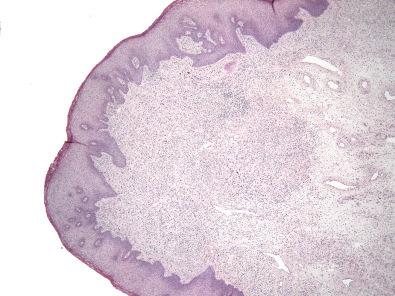
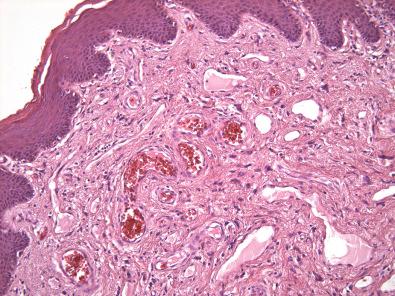
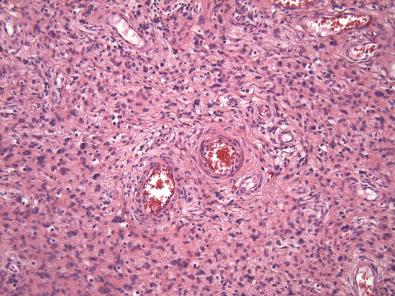
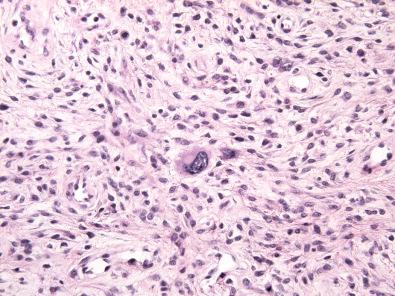
The stromal cells may be positive for desmin, actin, ER, and PR. Expression of RB1 (retinoblastoma) is intact. This immunoprofile is similar to nonneoplastic vulvovaginal mesenchyme.
Deep (aggressive) angiomyxoma enters into the differential diagnosis of fibroepithelial stromal polyp because it is also a vascular lesion with a loose spindled stroma. However, deep angiomyxoma characteristically involves deep soft tissue (i.e., not superficial or polypoid), is infiltrative, and has a uniformly distributed vascular component (rather than a vascular core). Myxoid stroma and perivascular cuffing by collagen and myoid bundles are also features of deep angiomyxoma that are not seen in fibroepithelial stromal polyps. Because the stromal cells of both lesions can be positive for desmin and actin, immunohistochemistry is not discriminatory.
Angiomyofibroblastoma and fibroepithelial stromal polyp both typically occur in adult women. However, the former is characteristically a well-circumscribed subcutaneous mass rather than a polypoid mucosal lesion. Histologically, angiomyofibroblastoma has a more prominent vascular component composed of numerous delicate capillary-sized vessels; this differs from the typically centrally located and larger, thicker-walled vessels of stromal polyps. In addition, the stromal cells of angiomyofibroblastoma often have an epithelioid appearance with more abundant eosinophilic cytoplasm that more frequently cluster around the prominent blood vessels. Both lesions can exhibit desmin and, less commonly, actin reactivity; therefore immunohistochemistry is not helpful.
Superficial angiomyxoma and fibroepithelial stromal polyps are superficially located lesions that both occur in adult women. The former has a multinodular growth pattern, an abundant myxoid matrix, and a characteristic neutrophilic infiltrate that does not correlate with erosion or ulceration. In one-third of cases, superficial angiomyxoma is associated with an epithelial component in the form of squamous epithelial-lined cysts (epidermoid cysts), buds of basaloid cells, or strands of squamous cells (likely due to adnexal entrapment, present in either the primary lesion or the recurrence). Furthermore, superficial angiomyxoma lacks the stellate and multinucleate stromal cells characteristic of stromal polyps.
Sarcomas are often considered in the differential diagnosis of stromal polyps with increased cellularity, cytologic atypia, and mitotic activity. Although the pitfall of mistaking pseudosarcomatous polyps during pregnancy may be well known, these worrisome histologic findings are not limited to pregnancy-associated polyps; thus it is important to be aware of features that are helpful in this distinction. Even in the most florid examples of pseudosarcomatous polyps, there is morphologic overlap with their more banal-appearing counterparts, including the (1) lack of an identifiable lesional margin, (2) extension of atypical stromal cells to the stromal-epithelial interface, and (3) frequent presence of multinucleate cells near the stromal-epithelial interface. Although often discussed, pseudosarcomatous polyps are readily distinguished from botryoid embryonal rhabdomyosarcoma (see Chapter 8 ) because they are rare before puberty and lack a subepithelial hypercellular (“cambium”) layer, rhabdomyoblasts, and skeletal muscle marker expression (e.g., myogenin).
Fibroepithelial stromal polyps are benign, and local excision is adequate. They may very rarely recur locally, particularly if incompletely excised, or if there is continued hormonal stimulation (e.g., pregnancy).
This benign polypoid growth arises from the distinctive subepithelial stroma of the distal female genital tract
Stellate and multinucleate stromal cells near the epithelial-stromal interface are characteristic
Some polyps show increased stromal cellularity, nuclear pleomorphism, and mitotic activity (“pseudosarcomatous”)
Pseudosarcomatous stromal changes are commonly, but not always, associated with pregnancy
Although originally described as occurring exclusively in the vulvovaginal region, angiomyofibroblastoma can also involve the inguinoscrotal region.
Angiomyofibroblastoma is a benign neoplasm that occurs almost exclusively in reproductive-aged women. Tumors are typically small (<5 cm) and well circumscribed and may be mistaken for a cyst on clinical examination. Rarely, they may be pedunculated.
Angiomyofibroblastoma is a well-circumscribed, tan to pink, soft tissue mass that usually has a soft or rubbery consistency. Histologically, it is well demarcated from surrounding soft tissue and composed of an admixture of numerous delicate thin-walled capillary-sized vessels and plump, round to spindle-shaped cells. These stromal cells, which are characteristically clustered around the prominent vessels, are set within a variably edematous to collagenous matrix with alternating zones of cellularity ( Fig. 17.7 ). They usually appear somewhat epithelioid (except in postmenopausal patients, where they are more often spindled), with moderate amounts of eosinophilic cytoplasm and nuclei with fine chromatin and inconspicuous nucleoli ( Figs. 17.8 and 17.9 ). Mitoses are uncommon, and intralesional adipose tissue may occasionally be present ( Fig. 17.10 ), and when prominent, the term “lipomatous variant” has been applied.
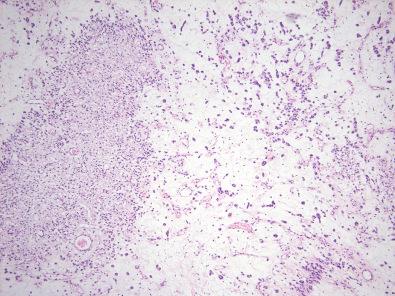
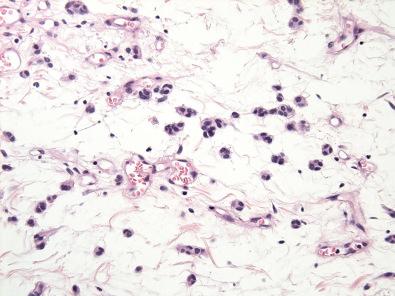
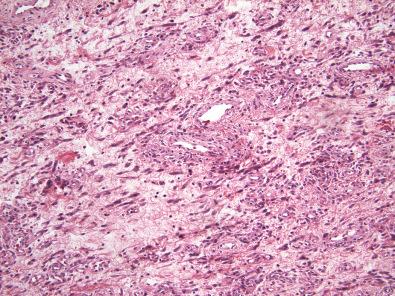
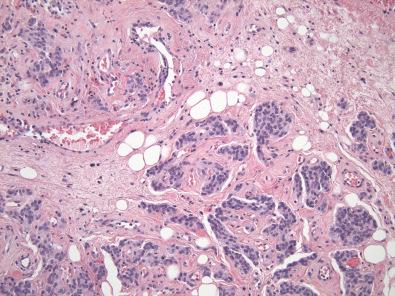
The stromal cells are typically positive for desmin, ER and PR and show variable reactivity for actin, although they are usually negative for this marker. CD34 is rarely positive, and expression of RB1 is typically intact. As for the other lower genital soft tissue tumors, immunohistochemistry plays a limited role in diagnosis.
These tumors do not appear to fall within the family of vulvovaginal neoplasms characterized by loss of genetic material at 13q14. The molecular pathogenetic basis for angiomyofibroblastoma has not yet been identified.
Become a Clinical Tree membership for Full access and enjoy Unlimited articles
If you are a member. Log in here